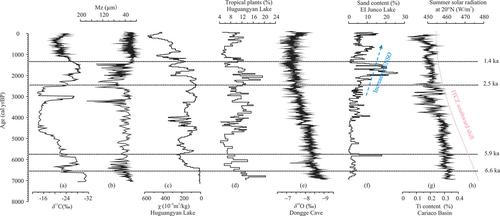当前位置:
X-MOL 学术
›
Acta Geol. Sinica Engl. Ed.
›
论文详情
Our official English website, www.x-mol.net, welcomes your feedback! (Note: you will need to create a separate account there.)
Evidence of Abrupt Climate Change during the Mid‐ to Late‐Holocene Recorded in a Tropical Lake, Southern China
Acta Geologica Sinica-English Edition ( IF 3.3 ) Pub Date : 2020-08-30 , DOI: 10.1111/1755-6724.14566 Yuan LING 1 , Wenkun TANG 1 , Yong WANG 1 , Jing DONG 1 , Fei TIAN 1 , lupeng YUAN 1 , Mengni YE 1
Acta Geologica Sinica-English Edition ( IF 3.3 ) Pub Date : 2020-08-30 , DOI: 10.1111/1755-6724.14566 Yuan LING 1 , Wenkun TANG 1 , Yong WANG 1 , Jing DONG 1 , Fei TIAN 1 , lupeng YUAN 1 , Mengni YE 1
Affiliation

|
Research on abrupt paleoclimatic and paleoenvironmental change provides a scientific basis for evaluating future climate. Because of spatial variability in monsoonal rainfall, our knowledge about climate change during the mid‐ to late‐Holocene in southern China is still limited. We present a multi‐proxy record of paleoclimatic change in a crater lake, Lake Shuangchi. Based on the age‐depth model from 210Pb, 137Cs and AMS14C data, high‐resolution mid‐ to late‐ Holocene climatic and environmental records were reconstructed using multiple indices (TOC, TN, C/N, δ13C and grain size). Shuangchi underwent a marked change from a peat bog to a lake around 1.4 kaBP. The C3 plants likely dominated during 7.0–5.9 ka and 2.5–1.4 kaBP, while C4 plants dominated between 5.9–3.2 and 3.0–2.5 kaBP. Algae were dominant sources of organic matter in the lake sediments after 1.4 kaBP. Several intervals with high concentrations of coarser grain sizes might be due to flood events. These results reveal that several abrupt paleoclimatic events occurred around 6.6 ka, 6.1 ka, 5.9 ka, 3.0 ka, 2.5 ka and 1.4 kaBP. The paleoclimatic change recorded in the lake may be related to the migration of the Intertropical Convergence Zone (ITCZ) and El Niño ‐ Southern Oscillation (ENSO) activity.
更新日期:2020-08-30


























 京公网安备 11010802027423号
京公网安备 11010802027423号